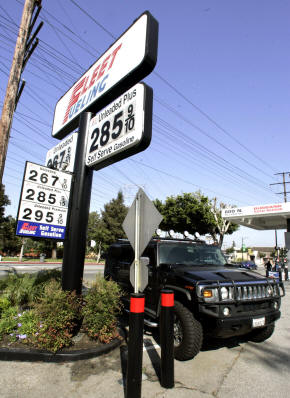From grain to gasoline: a brief world history of rationing
 Send a link to a friend
Send a link to a friend
 [July 28, 2022] (Reuters)
- European countries are looking at ways to
curb gas demand as they brace for further cuts in Russian supplies,
raising the prospect of rationing across the continent. [July 28, 2022] (Reuters)
- European countries are looking at ways to
curb gas demand as they brace for further cuts in Russian supplies,
raising the prospect of rationing across the continent.
Through war, siege and social strife, rich and poor countries across the
world have had a long and often painful history of rationing anything
from food to fuel and water, sometimes with unintended consequences.
Here is a brief timeline of some of those episodes.
1793-94 - The food crisis in the chaotic aftermath of the 1789 French
Revolution led Maximilien Robespierre's government to seek to control
grain from the fields right up to the mouths of consumers under a
rationing system backed by the guillotine. Its harshness finally led to
Robespierre's fall from power and his execution, also by the guillotine.
1914-18 - Many combatant nations of World War One suffered food
shortages as a result of the conflict, naval blockades and hoarding.
German food controls were infamously accompanied by unappetising ersatz
foods, such as "K-Brot", a bread substitute made from ingredients such
as dried potatoes and straw. Malnutrition was widespread as a result. No
rations were implemented in the United States but a "Food Will Win The
War" information campaign against food waste helped cut consumption.

1938 - As Japan waged war against China, it passed price caps and
rationing schemes on goods from sugar, rice and clothes to charcoal. The
government also propagated slogans such as "extravagance is our enemy"
to curb consumer demand and it encouraged households to grow vegetables
to supplement shrinking food supply. Rationing continued during World
War Two.
1940 - Britain introduced a food ration system a year after entering
World War Two, with each man, woman and child allotted coupons for the
purchase of basic foodstuffs including sugar, meat, fats, bacon and
cheese. Fruit and vegetables were not rationed and people were
encouraged to grow their own. Numerous studies have since pointed to the
benefical health effect of the diet. Food rationing did not end
completely until 1954.
1942 – Tyres were the first product to be rationed in the United States,
starting in January 1942, just weeks after the attack on Pearl Harbor.
Gasoline and food rationing began in May, starting with sugar, then
coffee and then meats, fats, canned fish, cheese, and canned milk the
year after. Macaroni and cheese became a recipe of choice for millions
because it required very few ration points. By the end of 1945, sugar
was the only commodity being rationed - a restriction which finally
ended in June 1947.
1945 - After the war, rationing behind the Communist-run Iron Curtain
was widespread but varied greatly between countries. In Hungary, it
largely affected non-essential items, including cars and telephone lines
- with years-long waiting lists as a result. In Poland it was more
severe, covering sugar, cigarettes, shoes, petrol, meat and basic food
essentials and led to hunger demonstrations and the growth of the
Solidarity movement by the early 1980s. "Do you know what a Polish
sandwich looks like? A meat ration card between two bread ration
tickets," went a dark Hungarian joke of the time.
[to top of second column] |

Signs advertising gasoline prices as high as $2.95 per gallon for
premium gasoline are pictured at Fleet Fueling as a Hummer vehicle
sits park next to the signs in Burbank, California April 13, 2005.
REUTERS/Fred Prouser/File Photo

1957 - After North Korea’s government launched a total collectivisation in the
1950s that allowed for only tiny family plots, food was collected and rationed
through public distribution. Food production was rarely able to meet basic
nutritional needs, leading to chronic food shortages. By the 1980s and early
1990s, the majority of the people were receiving only 10% to 30% of their
overall grain rations in the staple rice.
1973 - The oil embargo by Arab exporting states plunged Europe into a deep
energy crisis and forced a range of consumption-limiting measures. Denmark,
Italy, West Germany and others banned driving on a Sunday; France lowered speed
limits and stopped TV broadcasting at 11:00 pm to encourage people to go to bed.
Britain was spared petrol rationing by its North Sea oil but in London's West
End, some department stores resorted to old gas lighting to save electricity. In
Sweden, rationing and public campaigns led to longer-term changes that meant the
use of petroleum products had fallen by around 16% by 1980.
2011 – After a March 11 earthquake and tsunami triggered the Fukushima nuclear
accident and hit electricity supply to the Tokyo area, millions of Japanese were
left to cope with rolling blackouts. Gas stations were shut and rationed
purchases when they did open, while people were also left to queue for rationed
distribution of drinking water.
2014 – Venezuela’s Nicolas Maduro introduced a "Secure Food Supply" card setting
limits on purchases and intended to stop unscrupulous shoppers stocking up on
subsidised groceries and reselling them.

2020 – Cuba's rationing system - introduced shortly after Fidel Castro's 1959
leftist revolution but slated for elimination – made a comeback during the
COVID-19 pandemic to try to prevent Cubans from exposing themselves to the virus
on frantic shopping hunts. Basic items like laundry soap and washing-up liquid
become subject to rationing because of widespread shortages. Around the world,
reports emerged of ad hoc rationing in some shops and supermarkets as the
pandemic disrupted supplies.
(Reporting by Reuters bureaus, compiled by Mark John; editing by Barbara Lewis)
[© 2022 Thomson Reuters. All rights
reserved.]This material may not be published,
broadcast, rewritten or redistributed.
Thompson Reuters is solely responsible for this content. |